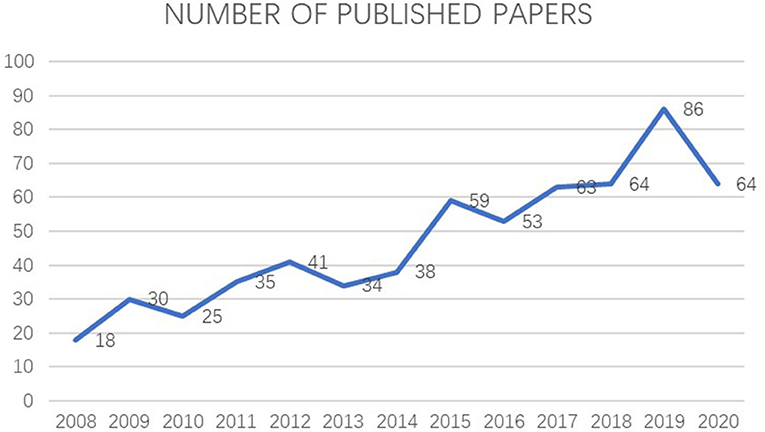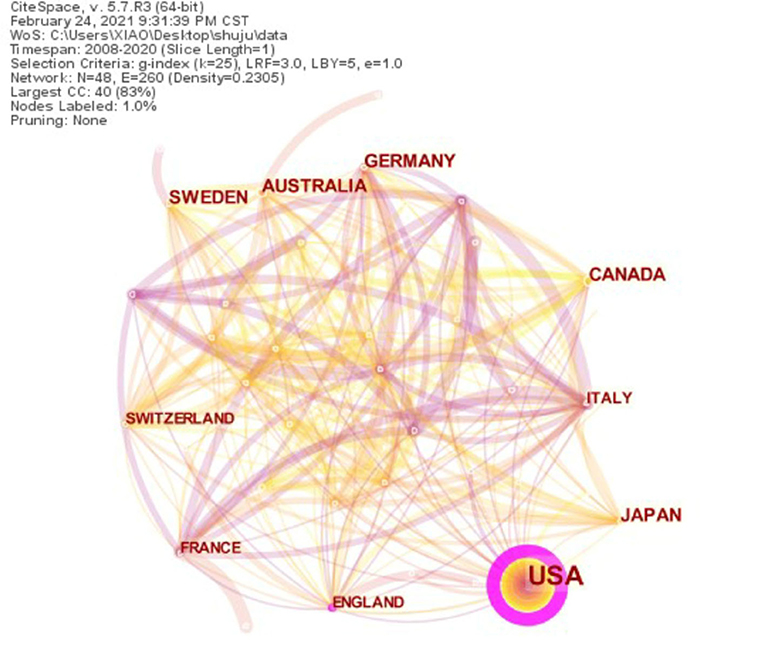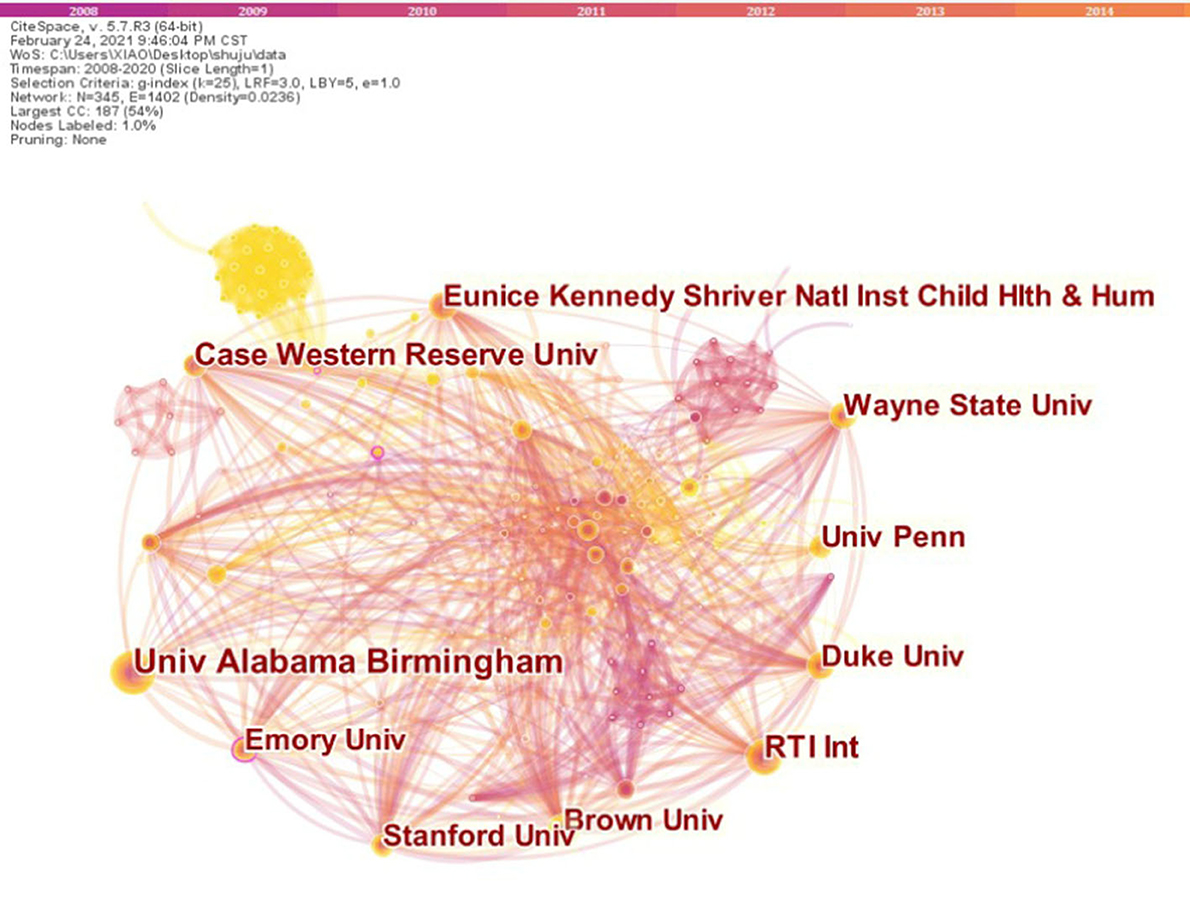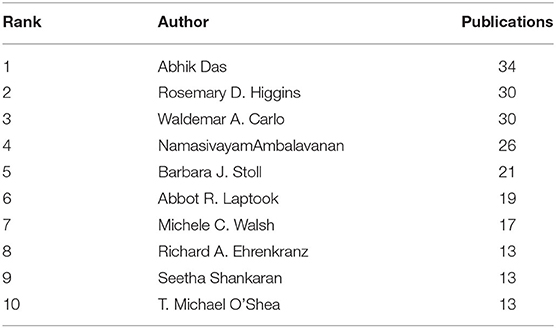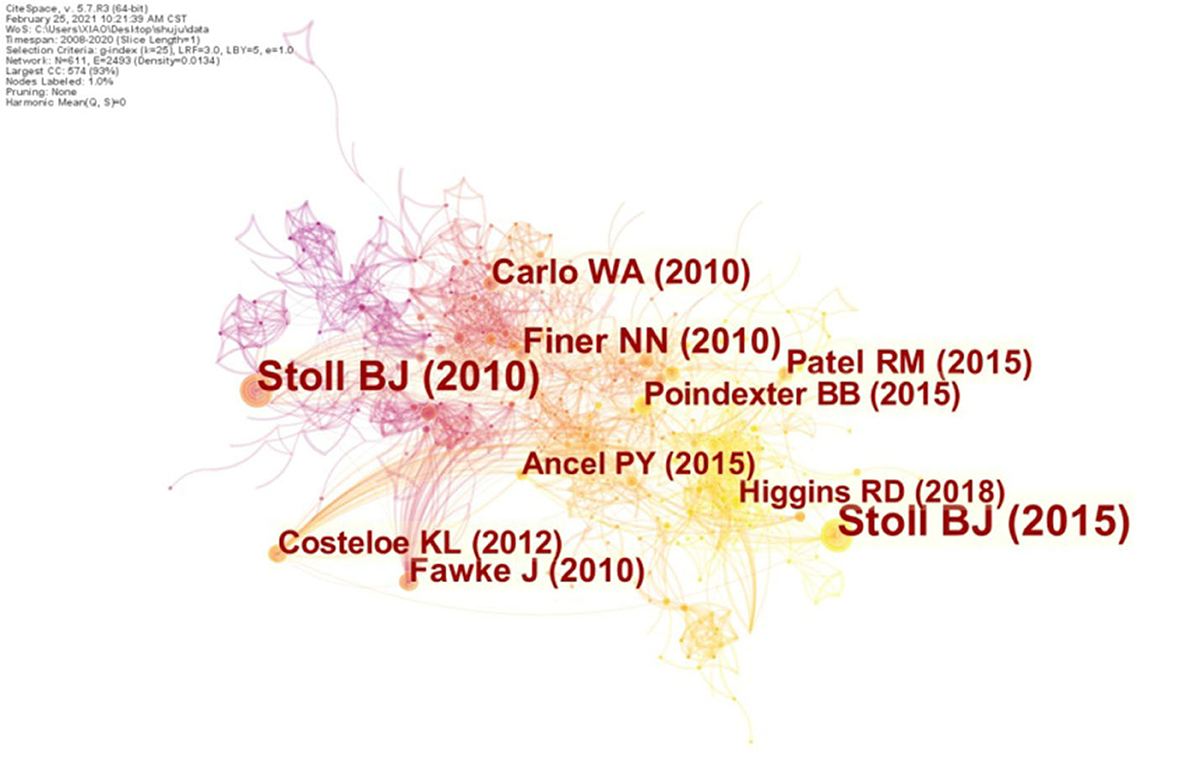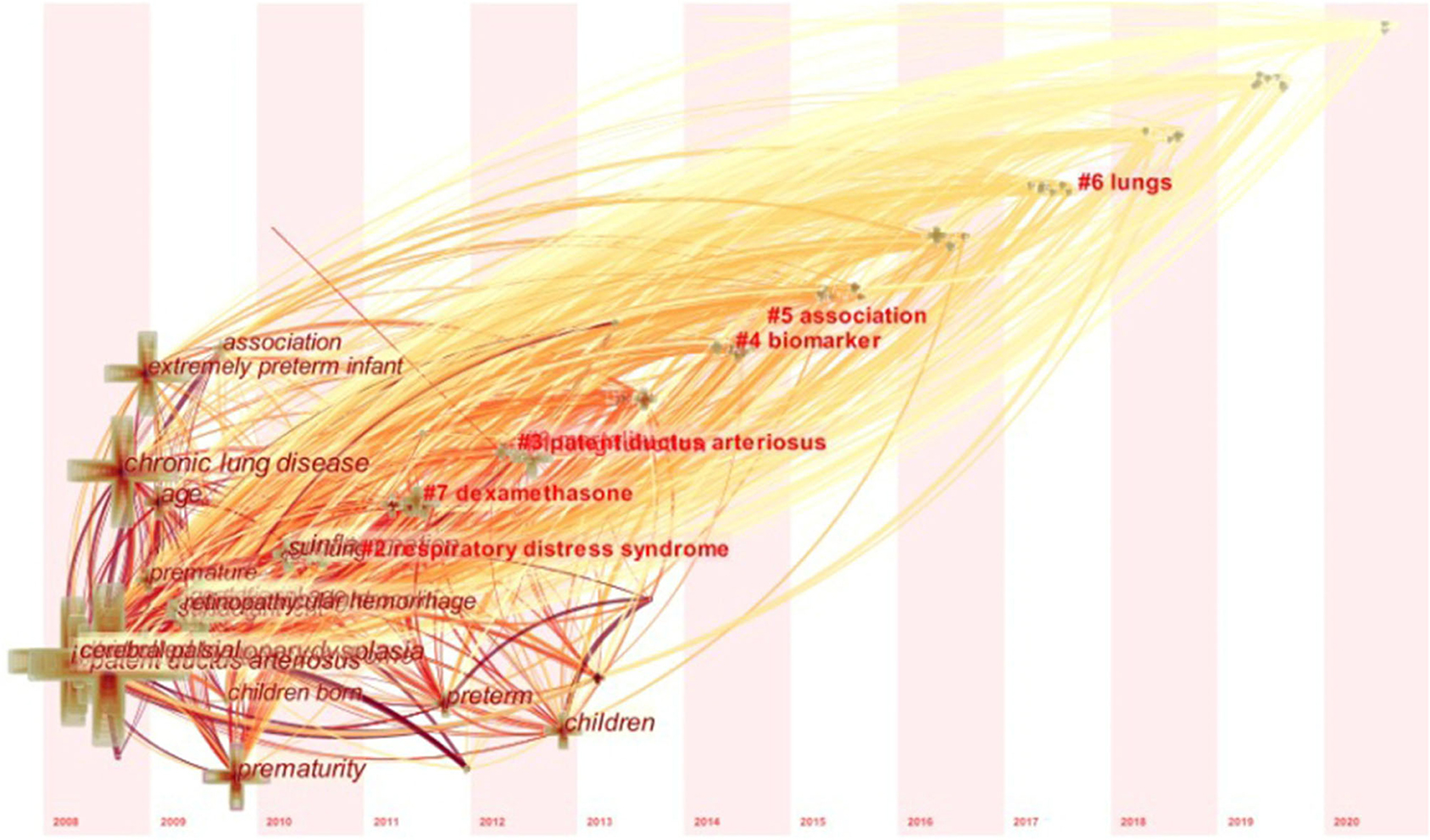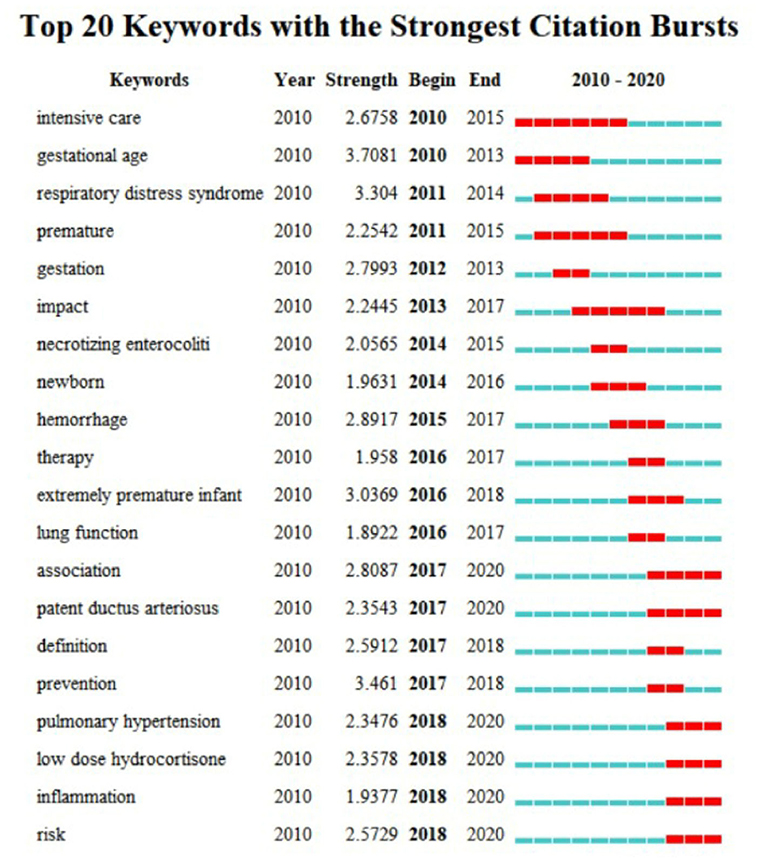- 1Department of Pediatrics, Zhejiang Provincial People's Hospital, People's Hospital of Hangzhou Medical College, Hangzhou, China
- 2Department of Neonatology, Hangzhou Children's Hospital, Hangzhou, China
Objectives: To review the literature related to bronchopulmonary dysplasia in extremely pre-mature infants, summarize research direction, and report trends.
Methods: CiteSpace is a Java application which supports visual exploration with knowledge discovery in bibliographic databases. Relevant articles from 2008 to 2020 were retrieved from the Web of Science Core Collection database, and we extracted the following data: title, abstract, year, keywords, author, organization, journal and cited literature. We downloaded the data into CiteSpace (version 5.7.R3) to summarize countries, institutions, journals, and authors. We visualized the data with a knowledge map, collaborative network analysis, cluster analysis, and burst keyword analysis.
Results: We identified 610 articles on bronchopulmonary dysplasia in extremely pre-mature infants. The United States had the most articles on this topic (302 articles), followed by Canada (49 articles) and Germany (44 articles). The top three institutions, high-yield journals, and authors were all from the United States. The most common keywords were neurodevelopmental disorders, active perinatal care, mechanical ventilation, inflammation, pulmonary hypertension, low-dose hydrocortisone, development, and patent ductus arteriosus.
Conclusions: This study illustrates the trends and frontiers in the study of bronchopulmonary dysplasia in extremely pre-mature infants. The current research direction is to identify the risk factors in developing bronchopulmonary dysplasia in extremely pre-mature infants.
Introduction
With the improvement of neonatal treatment, the survival rate of extremely pre-mature infants has increased significantly. Consequently, the incidence of bronchopulmonary dysplasia (BPD) is also increasing. Studies have shown that the incidence of BPD in extremely pre-mature infants with a gestational age of 22–27 weeks is 45% (1). The mortality and complication rate of pre-term infants with BPD is significantly higher than that of general pre-term infants. The prevention and management of BPD has become a major challenge in the field of perinatal and neonatal medicine. We conducted a literature review to further understand the research direction of bronchopulmonary dysplasia in extremely pre-mature infants and guide targeted research.
Bibliometrics is a text mining and analysis method that summarizes and analyzes research papers and academic journals. CiteSpace (http://cluster.cis.drexel.edu/~cchen/citespace/download/) is a scientific software that is often used to detect and visualize current scientific knowledge, detect trends in the literature, and determine future research directions (2, 3). CiteSpace uses information from the Web of Science Core Collection (WOSCC) and other database networks (4). This method can evaluate the corresponding data around knowledge gap involving important information including authors, journals, research institutions and keywords, and has been widely used in many fields such as medicine, geology, and ecology (5–7).
As far as we know, bibliometric techniques have not been applied to the area of BPD in extremely pre-mature infants. In this study, we used CiteSpace software to visualize how literature is developing investigating BPD in extremely pre-mature infants. We discuss the research directions in this field.
Methods
Data Sources
We used CiteSpace 5.7.R3 for the bibliometrics and visualization analysis, which was designed to provide critical information of the current knowledge for bronchopulmonary dysplasia in extremely pre-mature infants, including the fast-growth topical areas and citation hotspots. The articles were identified from a literature search using the WOSCC.
Search Parameters
Our retrieval used the following Core Collection of Web of Science (WOS): SCI-EXPANDED, SSCI, A&HCI, CPCI-S, CPCI-SSH, BKCI-S, BKCI-SSH, ESCI, CCR-EXPANDED, and IC. We performed a Boolean search on two lists with the operator “and.” The first list included the following search structure: TS = (Infant, Extremely Pre-mature* OR Extremely Pre-mature Infant* OR Infants, Extremely Pre-mature* OR Pre-mature Infant, Extremely* OR Pre-mature Infants, Extremely* OR Extremely Pre-term Infants* OR Extremely Pre-term Infant* OR Infant, Extremely Pre-term* OR Infants, Extremely Pre-term* OR Pre-term Infant, Extremely* OR Pre-term Infants, Extremely* OR Extremely Pre-mature Infants*). The second list included the following search structure: TS = (“Bronchopulmonary Dysplasia” OR “Dysplasia, Bronchopulmonary”). We searched articles (Document Type) in English (Languages) published between 2008 and 2020 (Retrieval time; Retrieval deadline: 2020.12.31).
Data Export
This retrieved articles, which were then exported using the “other file format,” which we defined as “plain text.” The exported record content was “full records and cited references.”
Analysis
We used the CiteSpace software to identify the citation bursts for the publication year, country/region, research institution, journal, author, research hotspot, and keywords.
This information was then presented as a knowledge graph using the following parameters: a 13-year period and a time slice of 1 year. The Term Sources were “Title, Abstract, Author Keywords (DE), and Keywords Plus (ID).” We set the Links parameters are “Strength: Cosine,” “Scope: Within Slices.”
In the network graph, different nodes represented various elements such as authors, institutions, countries, and keywords. The size of the nodes reflects the number or frequency of publications; the larger the node, the higher the number or frequency of publications. The connection lines between the nodes reflect the relationship between the co-operation or co-citation, the different colors within the nodes represent different times, and the color of the line reflects the years when the co-operation or co-citation first appeared (8). In addition, centrality reflects the role of the nodes in the knowledge network, and indicates the influence of one node on the other nodes. Nodes with greater centrality are more likely to become the key nodes in the network (9).
Results
Publication Years
We retrieved 610 documents related to BPD in extremely pre-mature infants. As shown in Figure 1, the number of related research articles on this topic is proliferating. The number of articles published increased from 18 in 2008 to 64 in 2020, showing that this research continues to develop and is one of the current hotspots in pediatrics (Figure 1).
Countries and Institutions Analysis
We analyzed each country's cooperation network map for this topic (Figure 2) and used the Web of Science retrieval results to get the top 10 countries by the number of publications (Table 1). The United States has the most significant number of articles, followed by Canada, Germany, and Australia, showing that the countries mentioned above are in a leading position on this topic. The United States has a high national centrality (Act as an intermediary in the partnership) and plays an intermediary role in the national cooperation network. In other countries, centrality is relatively low, which shows that most institutions have a low influence and cooperation.

Table 1. Top 10 countries and institutes publishing research on BPD in extremely pre-mature infants.
The top 5 institutions accounted for 320 articles (52.46%, Table 1). The top 5 research institutions are all in the United States: University of Alabama Birmingham, Case Western Reserve University, RTI International, Brown University, and Emory University. This finding shows that American research institutions are vital in the research field of BPD in extremely pre-mature infants, and they have carried out more in-depth and lasting research on the project with fruitful results. These research institutions have a dense network of cooperation, and they have more collaboration with other institutions (Figure 3).
Journal and Author Analysis
Table 2 lists the top 10 journals by the number of publications. Among these journals, American journals account for five, and the remaining five are from European countries. The top 10 authors of the number of articles published in this field are all Americans (Table 3), indicating the significant research in this field is in the United States.
Cited Literature and Author Analysis
Table 4 and Figure 4 lists the most cited documents in this field. Among these documents, the author, Barbara Stoll (Emory University, United States), has the top two papers in terms of the number of citations in this area (Table 4). It shows that she has made outstanding contributions in this research direction. Most of the top five citations are published in the TOP journals: American Journal of Respiratory and Critical Care Medicine [Impact factor (IF) = 21.405], JAMA - Journal of the American Medical Association (IF = 56.272), New England Journal of Medicine (IF = 91.245), and Pediatrics (IF = 7.124). This pattern shows that the research results in BPD in extremely pre-mature infants are of great significance.
High-Frequency Keywords Analysis
The differences in high-frequency keywords at different periods show that the focus of research on BPD in extremely pre-mature infants has changed over the years. Before 2016, a significant number of articles on BPD in extremely pre-mature infants looked at an association with intrauterine infections. After 2016, the literature is more focused on treating BPD in extremely pre-mature infants and has increased significantly. Research on therapeutic drugs shifted from early dexamethasone to low-dose hydrocortisone. Caffein, inhaled nitric oxide, mesenchymal stem cells, vitamin D deficiency and supplementation, and others (Table 5), have also become new high-frequency keywords (Figure 5).
Keywords With Citation Bursts
Figure 6 shows the top 20 keywords with the most substantial citation bursts. The blue line represents the time interval, while the red line shows the period in which a keyword had a burst. The keywords show the forefront of research on this topic. In the study of BPD in extremely pre-mature infants, the keywords with large mutation values that lasted until 2020 are highlighted: high-risk factors, inflammation, low-dose hydrocortisone, pulmonary hypertension, and patent ductus arteriosus. These may be the future trend of BPD research in extremely pre-mature infants.
Discussion
We have analyzed the number of publications, countries, high-impact journals, and authors researching BPD in extremely pre-mature infants. We found that over the last 13 years, countries worldwide have increased research on this topic. The top 10 publications are all in developed countries, with the United States having the highest number of publications, academic institutions, high-impact journals, and authors.
The analysis of the results of both high-frequency keywords and keywords with citation bursts shows that the research focus of BPD in extremely pre-mature infants has changed over time. Since 2008, exploring the high-risk factors of BPD in extremely pre-mature infants has been a research hotspot that has determined that the occurrence of BPD is the result of multiple factors. Gestational age (GA), low birth weight, intrauterine infection, maternal chorioamnionitis, lung inflammation, and respiratory distress syndrome (RDS) are important factors in the pathogenesis of BPD. Since 2016, the interest in the relationship between patent ductus arteriosus (PDA) and BPD has gradually increased. Some research believed PDA with the hemodynamic effects due to the large left-to-right shunt, can cause pulmonary edema, which leads to prolonged mechanical ventilation time and increases the risk of developing BPD (10, 11). However, it is still not clear that interventions to close the PDA to reduce the risk of BPD in humans. Multiple studies suggest that the development of BPD is unchanged regardless of the PDA treatment strategy (12, 13).
Glucocorticoids have always been the most studied and, at the same time, the most controversial class of drugs for treating BPD in extremely pre-mature infants. Based on high-frequency keywords, the research on glucocorticoids has increased in the past 5 years. Currently, the short-term, low-dose dexamethasone regimen is still the most widely used (14). Short-term adverse effects include high blood pressure, hyperglycemia, gastrointestinal bleeding, and gastrointestinal perforation when using hormones in pre-mature infants. The hormones have adverse effects on neurodevelopment, including an increased risk of cerebral palsy (15). As a result, a high-dose long-term hormone to prevent BPD or as early treatment has been abandoned (16). Efficacy and safety of hormone therapy for bronchopulmonary dysplasia in extremely pre-mature infants need larger, multicenter, randomized, controlled trials.
In terms of other drug treatments for BPD in extremely pre-mature infants, research into caffeine and mesenchymal stem cell treatment has increased significantly in recent years. Most scholars believe that early use of caffeine is beneficial as a treatment of BPD (17, 18). Caffeine use within 48 h of birth can allow the removal of the ventilator earlier and reduce the incidence of BPD, PDA, and neurodevelopmental deficits (19). However, a randomized, placebo-controlled trial showed that early initiation of caffeine in pre-term infants did not reduce the age of first successful extubation. The finding suggest caution with early use of caffeine in mechanically ventilated pre-term infants until more efficacy and safety data become available (20). Therefore, more research is needed to clarify the starting time and duration of caffeine treatment.
In the past 5 years, several trials have investigated the treatment of BPD with cell therapy. Mesenchymal stem cells (MSCs) derived from human cord blood have received particular attention due to their easy isolation, low immunogenicity, and anti-inflammatory and repair properties. Four countries, South Korea (21), the United States (22), Spain (23), and China (24), have successfully carried out phase I or II clinical trials of MSCs to treat BPD. Published results show that intravenous or intratracheal injection of MSCs can change the composition of inflammatory factors in airway secretions, reduce lung inflammation and fibrosis, and reduce the severity of BPD; to date, no adverse reactions have been found (25). However, the mechanism of MSCs in repairing BPD is unclear. Therefore, the study of the pathophysiology of BPD, the use of MSCs for treatment, and transforming cell therapy into clinical use will be important areas of future research.
Research hotspots in the past 5 years have shown that research has gradually moved toward the complications and prognosis of BPD in extremely pre-mature infants. Neurodevelopmental disorders and pulmonary hypertension (PH) are the two major complications of BPD. The long-term neurodevelopmental outcome of pre-term infants with BPD is significantly higher than that of non-BPD pre-term infants (26). Neurodevelopment disorders risk factors include infections, poor growth, birth hypoxia, and later steroid use. PH is the most severe complication of BPD (27), with an incidence rate of 14–50% (28). This complication can progress to pulmonary heart disease (PHD) and significantly affect long-term prognosis. BPD-related PH has a mortality rate of up to 40% before 2 years of age (29).
Strengths and Limitations
To our knowledge, this is the first study to use the co-occurrence and co-citation analysis methods by CiteSpace to perform bibliometric analysis and visual display of bronchopulmonary dysplasia in extremely pre-mature infants.
Our study does have limitations. We analyzed only English studies in the WOS due to software limitations. Therefore, the data may not be comprehensive, and our results may not be applicable to research published in other languages. Synonyms, when clustering keywords, can cause some overlaps between different categories of contents.
Conclusions
We can determine the research status of BPD treatments and pathophysiology using CiteSpace. At present, the research hotspots of BPD tend to be the rational use of hormones, cell therapy, early detection, and follow-up of complications. Understanding the pathogenesis and treatment prospects of BPD in the future requires continuously discovering and solving related problems.
Author Contributions
QZ and S-YZ designed the research subject. H-BK and QZ conducted literature retrieval and screening. B-MH and H-BK provided guidance in statistical analysis. QZ wrote the manuscript. S-YZ critically revised the manuscript. All authors read and approved the final manuscript.
Conflict of Interest
The authors declare that the research was conducted in the absence of any commercial or financial relationships that could be construed as a potential conflict of interest.
Publisher's Note
All claims expressed in this article are solely those of the authors and do not necessarily represent those of their affiliated organizations, or those of the publisher, the editors and the reviewers. Any product that may be evaluated in this article, or claim that may be made by its manufacturer, is not guaranteed or endorsed by the publisher.
Acknowledgments
We would like to thank TopEdit (www.topeditsci.com) for English language editing of this manuscript.
References
1. Stoll BJ, Hansen NI, Bell EF, Walsh MC, Carlo WA, Shankaran S, et al. Trends in care practices, morbidity, and mortality of extremely preterm neonates, 1993-2012. JAMA. (2015) 314:1039–51. doi: 10.1001/jama.2015.10244
2. Yao L, Hui L, Yang Z, Chen X, Xiao A. Freshwater microplastics pollution: detecting and visualizing emerging trends based on Citespace II. Chemosphere. (2020) 245:125627. doi: 10.1016/j.chemosphere.2019.125627
3. Chen C. Searching for intellectual turning points: progressive knowledge domain visualization. Proc Natl Acad Sci USA. (2004) 101(Suppl. 1):5303–10. doi: 10.1073/pnas.0307513100
4. Gao Y, Shi S, Ma W, Chen J, Cai Y, Ge L, et al. Bibliometric analysis of global research on PD-1 and PD-L1 in the field of cancer. Int Immunopharmacol. (2019) 72:374–84. doi: 10.1016/j.intimp.2019.03.045
5. Mund M, Kloft B, Bundschuh M, Klingelhoefer D, Groneberg DA, Gerber A. Global research on smoking and pregnancy-a scientometric and gender analysis. Int J Environ Res Public Health. (2014) 11:5792–806. doi: 10.3390/ijerph110605792
6. Dufault B, Klar N. The quality of modern cross-sectional ecologic studies: a bibliometric review. Am J Epidemiol. (2011) 174:1101–7. doi: 10.1093/aje/kwr241
7. Zheng M, Fu HZ, Ho YS. Research trends and hotspots related to ammonia oxidation based on bibliometric analysis. Environ Sci Pollut Res Int. (2017) 24:20409–21. doi: 10.1007/s11356-017-9711-0
8. Liang C, Luo A, Zhong Z. Knowledge mapping of medication literacy study: a visualized analysis using CiteSpace. SAGE Open Med. (2018) 6:2050312118800199. doi: 10.1177/2050312118800199
9. Chen C, Chen Y. Searching for clinical evidence in CiteSpace. AMIA Annu Symp Proc. (2005) 2005:121–5.
10. El-Khuffash A, James AT, Corcoran JD, Dicker P, Franklin O, Elsayed YN, et al. A patent ductus arteriosus severity score predicts chronic lung disease or death before discharge. J Pediatr. (2015) 167:1354–61.e2. doi: 10.1016/j.jpeds.2015.09.028
11. Clyman RI, Hills NK, Liebowitz M, Johng S. Relationship between duration of infant exposure to a moderate-to-large patent ductus arteriosus shunt and the risk of developing bronchopulmonary dysplasia or death before 36 weeks. Am J Perinatol. (2020) 37:216–23. doi: 10.1055/s-0039-1697672
12. Willis KA, Weems MF. Hemodynamically significant patent ductus arteriosus and the development of bronchopulmonary dysplasia. Congenit Heart Dis. (2019) 14:27–32. doi: 10.1111/chd.12691
13. Clyman RI, Liebowitz M, Kaempf J, Erdeve O, Bulbul A, Hakansson S, et al. PDA-TOLERATE trial: an exploratory randomized controlled trial of treatment of moderate-to-large patent ductus arteriosus at 1 week of age. J Pediatr. (2019) 205:41–8.e6. doi: 10.1016/j.jpeds.2018.09.012
14. Doyle LW, Davis PG, Morley CJ, McPhee A, Carlin JB. Low-dose dexamethasone facilitates extubation among chronically ventilator-dependent infants: a multicenter, international, randomized, controlled trial. Pediatrics. (2006) 117:75–83. doi: 10.1542/peds.2004-2843
15. Doyle LW, Cheong JL, Ehrenkranz RA, Halliday HL. Late (> 7 days) systemic postnatal corticosteroids for prevention of bronchopulmonary dysplasia in preterm infants. Cochrane Database Syst Rev. (2017) 10:CD001145. doi: 10.1002/14651858.CD001145.pub4
16. Jefferies AL. Postnatal corticosteroids to treat or prevent chronic lung disease in preterm infants. Paediatr Child Health. (2012) 17:573–4. doi: 10.1093/pch/17.10.573
17. Schmidt B, Roberts RS, Davis P, Doyle LW, Barrington KJ, Ohlsson A, et al. Caffeine therapy for apnea of prematurity. N Engl J Med. (2006) 354:2112–21. doi: 10.1056/NEJMoa054065
18. Schmidt B, Roberts RS, Davis P, Doyle LW, Barrington KJ, Ohlsson A, et al. Long-term effects of caffeine therapy for apnea of prematurity. N Engl J Med. (2007) 357:1893–902. doi: 10.1056/NEJMoa073679
19. Lodha A, Seshia M, McMillan DD, Barrington K, Yang J, Lee SK, et al. Association of early caffeine administration and neonatal outcomes in very preterm neonates. JAMA Pediatr. (2015) 169:33–8. doi: 10.1001/jamapediatrics.2014.2223
20. Amaro CM, Bello JA, Jain D, Ramnath A, D'Ugard C, Vanbuskirk S, et al. Early caffeine and weaning from mechanical ventilation in preterm infants: a randomized, placebo-controlled trial. J Pediatr. (2018) 196:52–7. doi: 10.1016/j.jpeds.2018.01.010
21. Ahn SY, Chang YS, Lee MH, Sung SI, Lee BS, Kim KS, et al. Stem cells for bronchopulmonary dysplasia in preterm infants: a randomized controlled phase II trial. Stem Cells Transl Med. (2021) 10:1129–37. doi: 10.1002/sctm.20-0330
22. Powell SB, Silvestri JM. Safety of intratracheal administration of human umbilical cord blood derived mesenchymal stromal cells in extremely low birth weight preterm infants. J Pediatr. (2019) 210:209–13.e2. doi: 10.1016/j.jpeds.2019.02.029
23. Mesenchymal Stem Cell Therapy for Bronchopulmonary Dysplasia in Preterm Babies. ClinicalTrials.gov Identifier: NCT02443961. (Active, not recruiting).
24. Stem Cells for Bronchopulmonary Dysplasia. ClinicalTrials.gov Identifier: NCT03378063. (Recruiting).
25. Namba F. Mesenchymal stem cells for the prevention of bronchopulmonary dysplasia. Pediatr Int. (2019) 61:945–50. doi: 10.1111/ped.14001
26. Smith VC, Zupancic JA, McCormick MC, Croen LA, Greene J, Escobar GJ, et al. Rehospitalization in the first year of life among infants with bronchopulmonary dysplasia. J Pediatr. (2004) 144:799–803. doi: 10.1016/j.jpeds.2004.03.026
27. Krishnan U, Feinstein JA, Adatia I, Austin ED, Mullen MP, Hopper RK, et al. Evaluation and management of pulmonary hypertension in children with bronchopulmonary dysplasia. J Pediatr. (2017) 188:24–34.e1. doi: 10.1016/j.jpeds.2017.05.029
28. Mourani PM, Abman SH. Pulmonary hypertension and vascular abnormalities in bronchopulmonary dysplasia. Clin Perinatol. (2015) 42:839–55. doi: 10.1016/j.clp.2015.08.010
Keywords: bronchopulmonary dysplasia, extremely pre-mature infants, bibliometrics, CiteSpace, Web of Science
Citation: Zhou Q, Kong H-B, He B-M and Zhou S-Y (2021) Bibliometric Analysis of Bronchopulmonary Dysplasia in Extremely Premature Infants in the Web of Science Database Using CiteSpace Software. Front. Pediatr. 9:705033. doi: 10.3389/fped.2021.705033
Received: 04 May 2021; Accepted: 23 July 2021;
Published: 20 August 2021.
Edited by:
Giovanni Vento, Catholic University of the Sacred Heart, ItalyReviewed by:
Jonathan Michael Davis, Tufts University, United StatesChristoph Bührer, Charité – Universitätsmedizin Berlin, Germany
Copyright © 2021 Zhou, Kong, He and Zhou. This is an open-access article distributed under the terms of the Creative Commons Attribution License (CC BY). The use, distribution or reproduction in other forums is permitted, provided the original author(s) and the copyright owner(s) are credited and that the original publication in this journal is cited, in accordance with accepted academic practice. No use, distribution or reproduction is permitted which does not comply with these terms.
*Correspondence: Su-Ya Zhou, c3V5YS56aG91QDE2My5jb20=
 Qin Zhou
Qin Zhou Hai-Bo Kong
Hai-Bo Kong Bao-Mei He1
Bao-Mei He1 Su-Ya Zhou
Su-Ya Zhou